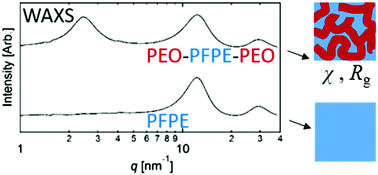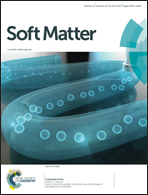Incipient microphase separation in short chain perfluoropolyether-block-poly(ethylene oxide) copolymers†
Abstract
Incipient microphase separation is observed by wide angle X-ray scattering (WAXS) in short chain multiblock copolymers consisting of perfluoropolyether (PFPE) and poly(ethylene oxide) (PEO) segments. Two PFPE–PEO block copolymers were studied; one with dihydroxyl end groups and one with dimethyl carbonate end groups. Despite having a low degree of polymerization (N ∼ 10), these materials exhibited significant scattering intensity, due to disordered concentration fluctuations between their PFPE-rich and PEO-rich domains. The disordered scattering intensity was fit to a model based on a multicomponent random phase approximation to determine the value of the interaction parameter, χ, and the radius of gyration, Rg. Over the temperature range 30–90 °C, the values of χ were determined to be very large (∼2–2.5), indicating a high degree of immiscibility between the PFPE and PEO blocks. In PFPE–PEO, due to the large electron density contrast between the fluorinated and non-fluorinated block and the high value of χ, disordered scattering was detected at intermediate scattering angles, (q ∼ 2 nm−1) for relatively small polymer chains. Our ability to detect concentration fluctuations was enabled by both a relatively large value of χ and significant scattering contrast.



 Please wait while we load your content...
Please wait while we load your content...